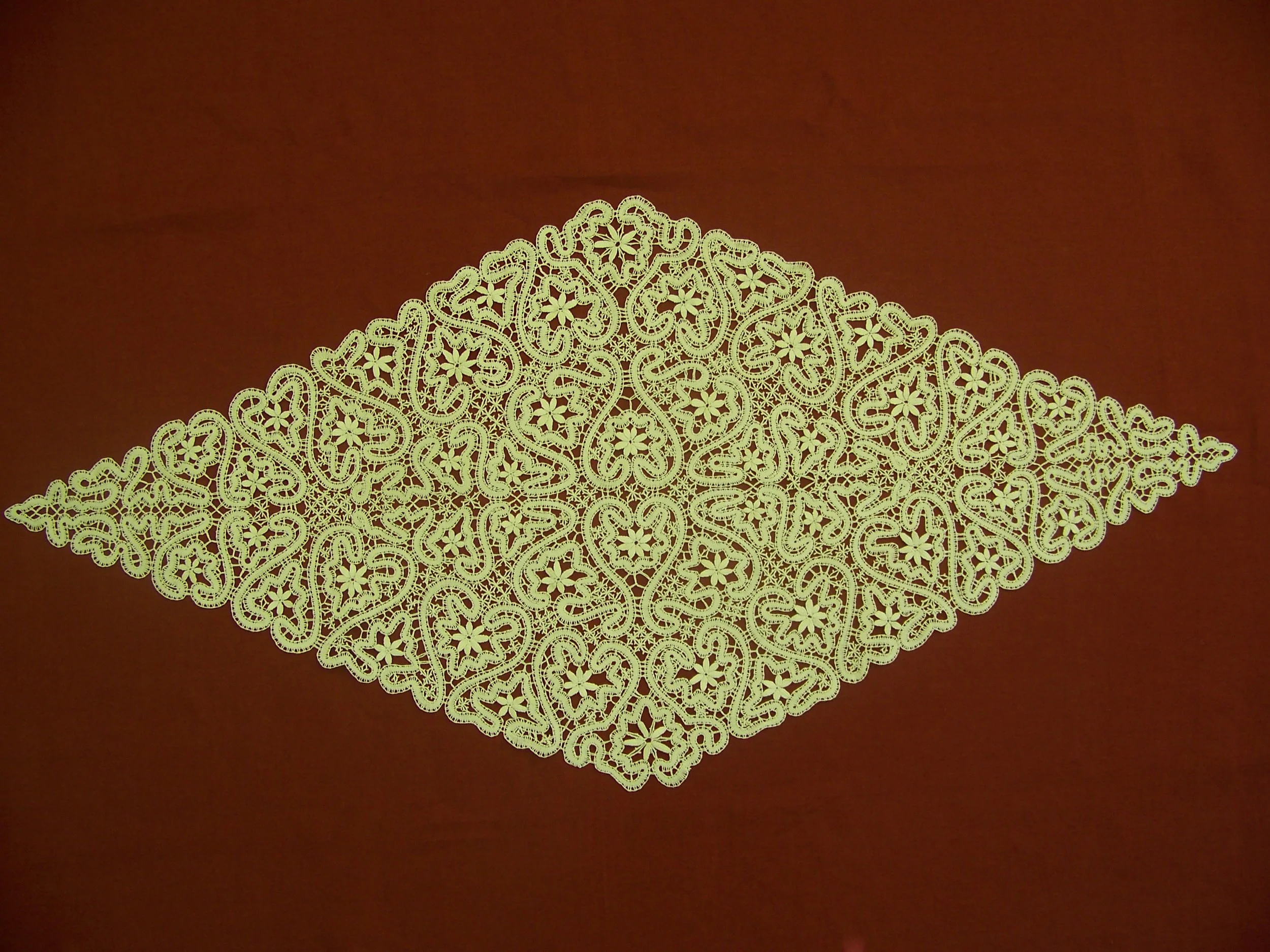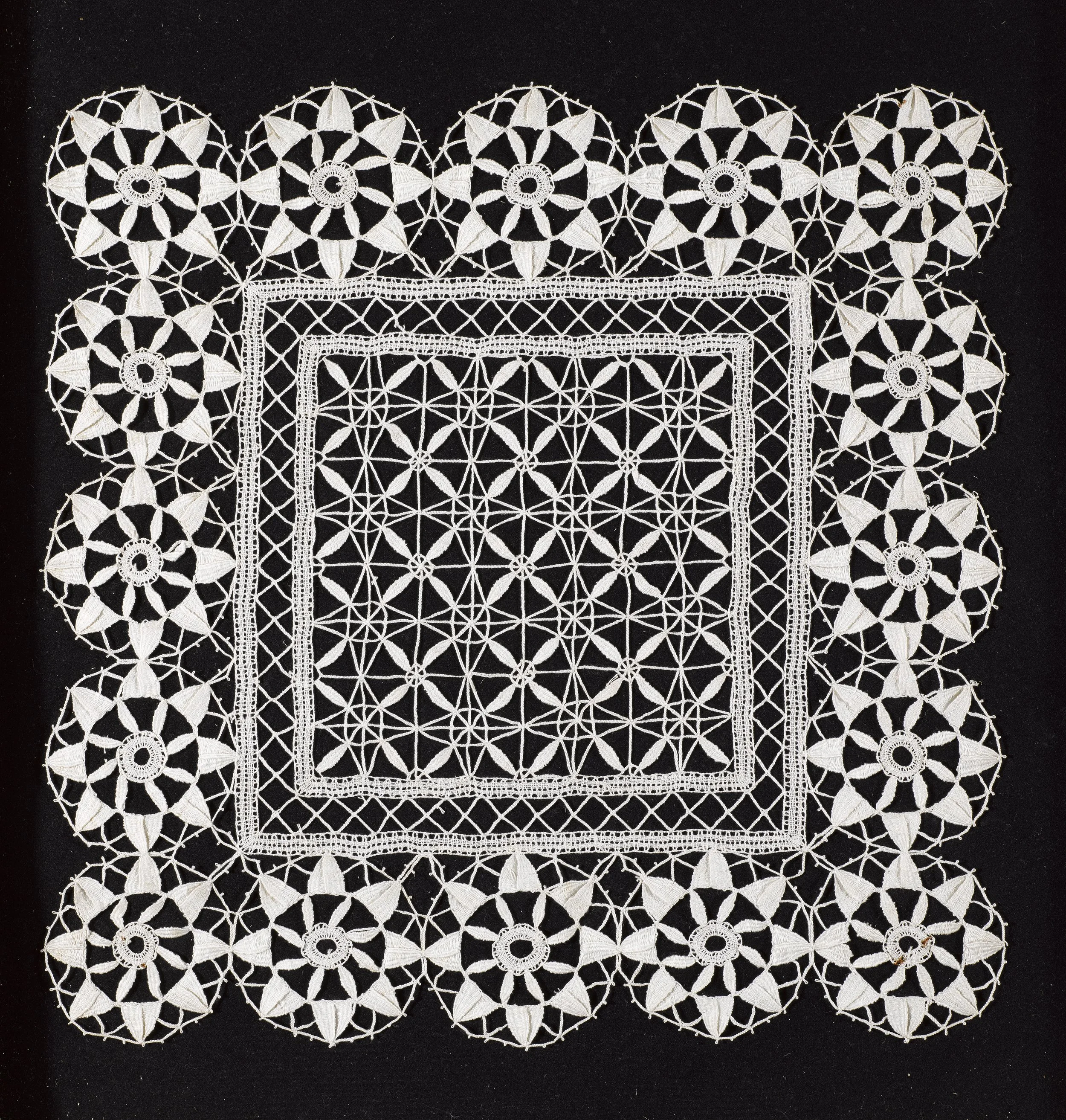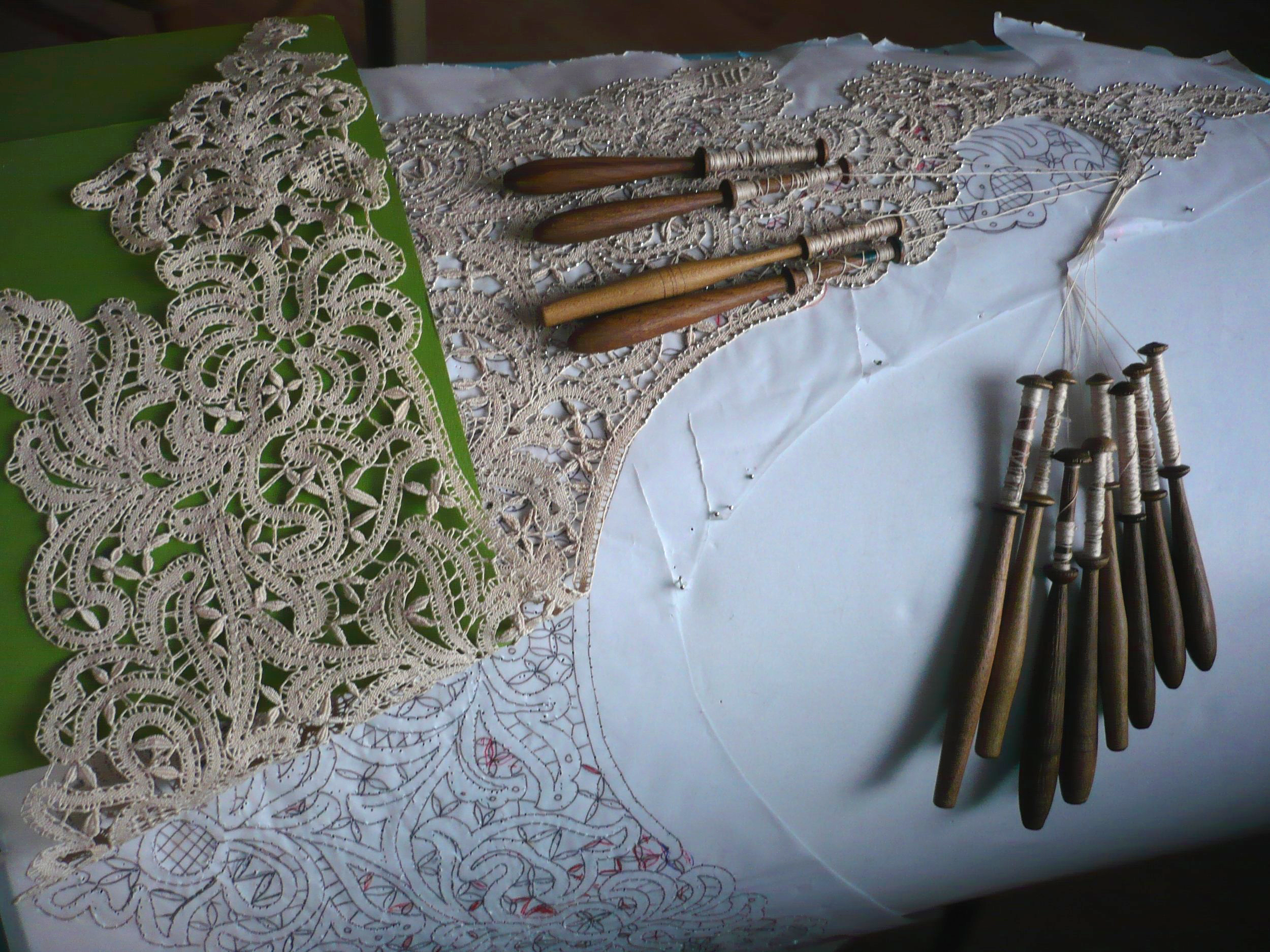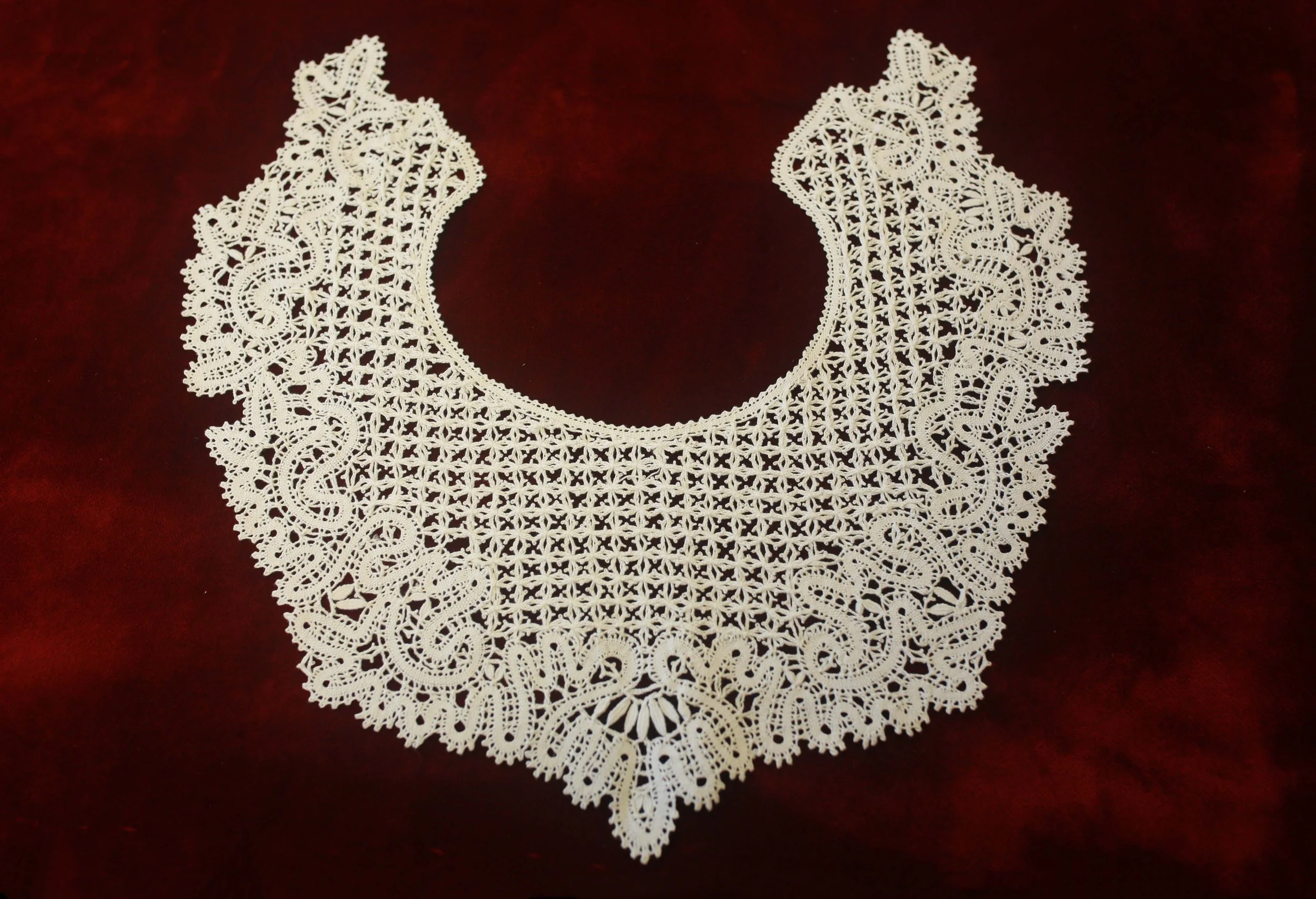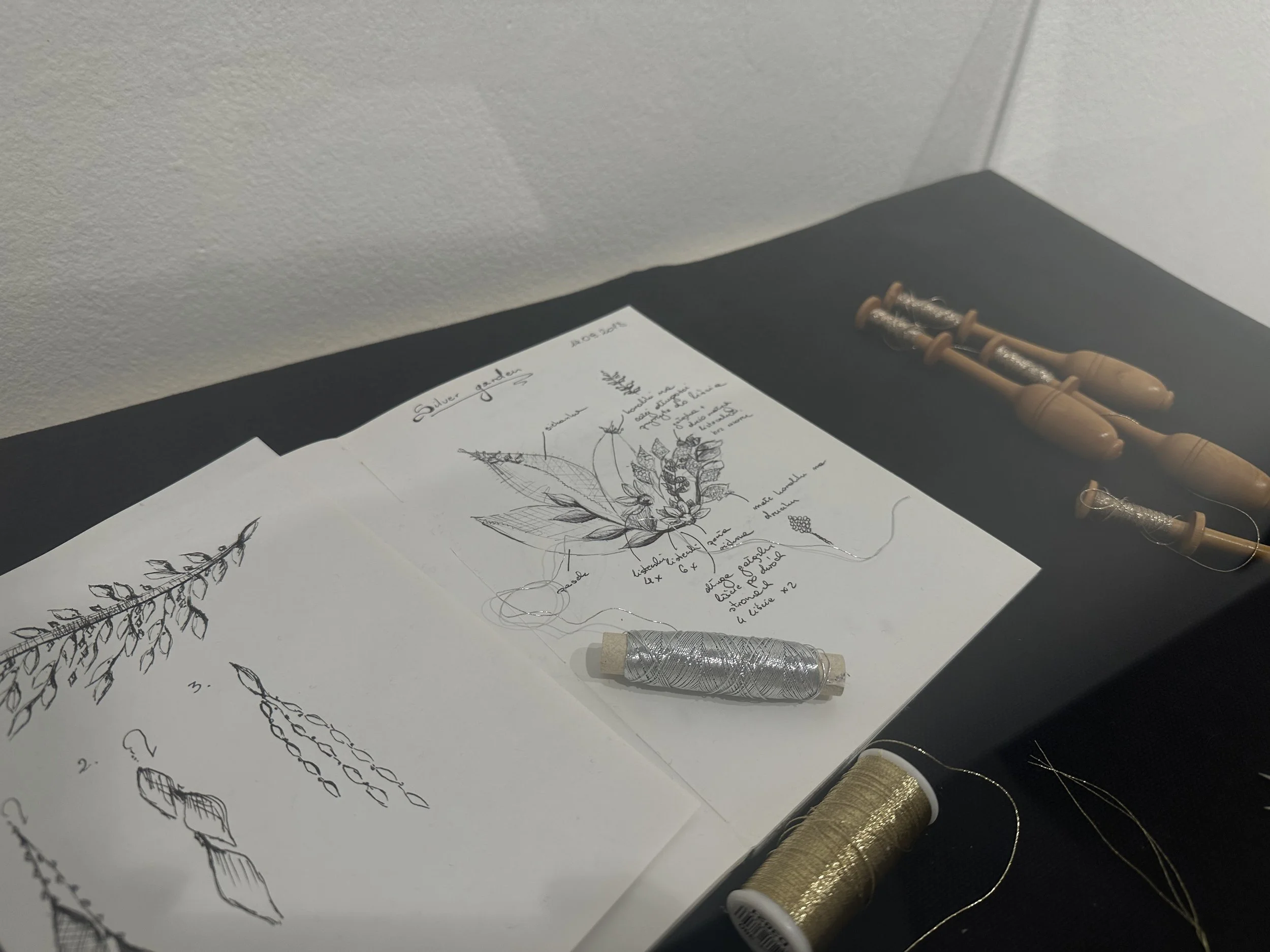BOBBIN LACE FROM POLAND
A Thread Between Then and Now
courtesy of Małgorzata Szpila
Bobbin lace is regarded the noblest of lacemaking techniques - so refined and intricate that it has long been known as the queen of lace. Created by braiding and twisting lengths of thread wound onto bobbins, the process requires not only precision but a quiet, almost musical sense of rhythm. As the lace grows, it is held in place with fine pins on a firmly stuffed pillow - traditionally filled with chopped hay and overlaid with a pricking pattern that guides each movement. Such a lacemaking workshop set truly looks like an artwork in its own right.
Though bobbin lace is most commonly associated with historic centres in Belgium, Italy, or Spain, it also found a quiet, enduring home in Poland. It’s thought to have arrived as early as the 16th century, possibly brought by Queen Bona Sforza, who invited Italian artisans to the Polish court. Others believe it travelled through Flanders. But it wasn’t until the late 19th century that the craft truly took root - when regional lace schools began to formalise the tradition and shape its unique Polish identity.
The first was established in Kańczuga in 1882, followed soon after by schools in Zakopane (1883), and Bobowa (1899). These institutions not only nurtured regional styles but elevated lace-making into a respected profession, and brought Polish lace international acclaim through awards and exhibitions in Glasgow, Saint Louis, Paris, and San Francisco.
Though all derived from the same technique, each centre developed its own distinct aesthetic, responding to local culture, climate, and materials. These stylistic differences continue to define the Polish lace landscape today.
Collaborations with fashion brands, like the memorable one with Chylak - as well as commissions from the film industry and museums - have brought renewed attention to the craft, offering artisans a sense of hope and confidence in its future. In their hands, the tradition endures, carried forward with care, devotion, and imagination.
This article celebrates the work of two artisans, each approaching the craft with a different style and perspective. One remains faithful to tradition, devoting her practice to reviving the Zakopane school of bobbin lace. The other hails from Bobowa but now threads new futures for the craft abroad, exploring form, function, and contemporary dimension of her heritage.
Magdalena Cieciwa’s work; courtesy of the artist
Magdalena Cięciwa - Reviving the Beauty of Zakopane Bobbin Lace
Magdalena Cięciwa was born in Limanowa and now lives and works in Marcinkowice. She grew up in a family rooted in craft traditions, and first encountered bobbin lace in the eighth grade of primary school. What began as a hobby soon became a lifelong passion. She learned the basics of lacemaking at workshops in Nowy Sącz led by lace makers from Bobowa, and then continued her studies with Mrs. Maria Tepper, a teacher at the Helena Modrzejewska Lacemaking School in Zakopane, and Zofia Wiercioch from Szczawnica. Today, she is one of the few artisans devoted to preserving the legacy of Zakopane-style bobbin lace.
To understand the significance of her work and the importance of the Zakopane-style, it’s best to begin with a bit of historical background.
At the turn of the 19th century, the Tatra Mountains and the surrounding Podhale region became a destination for Poland’s cultural elite. Zakopane attracted artists, writers, and intellectuals seeking inspiration in the dramatic landscape and rich folklore of the region. Alongside this romantic fascination came an awareness of the poverty experienced by the local highlander communities. In response, and thanks to a donation from the celebrated actress Helena Modrzejewska, the National School of Lacemaking was founded in 1883. Its mission was to provide young highlander women, predominantly from poorer backgrounds, with education and a way to earn a living through craft.
students from National School of Lacemaking in Zakopane; courtesy of Tatra Museum in Zakopane
reticella lace by Karol Kłosowski; courtesy of Tatra Museum in Zakopane
peacock feathers design by Karol Kłosowski; courtesy of Tatra Museum in Zakopane
The school offered far more than technical training. Curriculum involved reading, writing, arithmetic, and various lace-making techniques, including Czech and French guipure, Venetian lace, and reticella. The early teachers were trained in Vienna, which explains why the first patterns introduced were of foreign origin. Over time, however, the school developed its own artistic identity. This transformation is largely attributed to Karol Kłosowski - an accomplished artist, painter, and passionate admirer of Podhale. Between 1913 and 1932, he taught drawing and composition at the school, helping to establish it as a true artistic institution. The first designs of what we now recognise as “Zakopane lace,” rooted in the decorative vocabulary of Podhale, emerged during his tenure. In 1925, his lace designs inspired by highland ornamentation were presented at the International Exhibition of Decorative Arts in Paris, where they were awarded a gold medal.
Later on, despite periods of great difficulty including the war and the austerity of the communist era - the school endured and was shaped by a number of influential artists, including Maria Bujakowa. But in 2008, the institution had to close its doors. It was a time when traditional crafts were increasingly viewed as obsolete, outpaced by efficiency, convenience, and the influx of imported goods. With the school’s closure, many of its archival patterns were lost, and among them, Kłosowski’s original designs.
This is where Magdalena Cięciwa’s story begins again.
While clearing a fire-damaged villa in Zakopane, workers discovered a bundle of singed, brittle cardboard sheets. Torn and faded seemed completely worthless. But someone thought of Magdalena and handed them to her. Known locally for her devotion to Zakopane lace, she recognised the faint constellation of pinholes and guiding lines on the surfaces of those sheets. She knew these were not scraps. They were forgotten templates from the National School of Lacemaking, many of them designed by Karol Kłosowski himself.
Over a century ago, lace patterns were drawn by hand on cardboard. Time and neglect made most of them almost unreadable. Yet Magdalena, guided by her technical knowledge and instinctive feel for the craft, took on the painstaking work of redrawing the motifs, and reconstructing them. “You could only guess what had once been there by the shadows of pinpricks,” she recalls. From those barely-there traces, she brought these precious lace designs back to life.
Today, her collection includes around 300 reconstructed Zakopane lace designs, which serves as a vital record of the school’s artistic legacy. She is also leading efforts to have Zakopane-style bobbin lace inscribed on Poland’s National List of Intangible Cultural Heritage maintained by UNESCO.
Magdalena Cieciwa’s work; courtesy of the artist
lace collar; based on design from 1912; courtesy of Magdalena Cięciwa
lace collar detail; based on design from 1912;courtesy of Magdalena Cięciwa
lace collar; courtesy of Magdalena Cięciwa
Magdalena approaches the craft with contagious energy and unwavering commitment not only as a maker, reconstructor, and researcher, but also as a teacher. She regularly shares her knowledge through workshops and school visits, introducing lace-making to younger generations through hands-on, ethnographic lessons. With a background in Special Education focused on children with disabilities, she also designs weaving and lace-making courses as part of occupational therapy programmes. Through this work, she offers her students a sense of calm, purpose, and joy. Many of them, under her gentle guidance, discover talents they never knew they had.
Follow the Magdalena’s Facebook profile to stay up to date with her practice or initiate a collaboration.
Małgorzata Szpila - Bobowa Lace Reimagined
Born and raised in Bobowa, Małgorzata Szpila has been immersed in the craft since the age of 9. “There actually hasn't been a single year without lace in my life,” she says. Now 35, she works from her studio in Wales, creating intricate lace jewellery and luxurious accessories that reinterpret the heritage technique of her hometown with a fresh, contemporary sensibility.
But how did it start? Her entry into lace was almost inevitable. With her mother (an accomplished Bobowa lacemaker Ewa Szpila) working at the local cultural centre and a deep believer in the potential of lace to connect cultures, Małgorzata grew up surrounded by thread, tradition and passion. Yet what truly ignited her imagination was the first International Bobbin Lace Festival in Bobowa—a project co-organised by her mother. There, she discovered lace as a medium of artistic expression rather than one limited to traditional home decor. “It wasn’t just white or grey doilies lying under the TV anymore,” she recalls, laughing. “It was no longer seen purely as tradition,” Her eyes sparkle at the memory as if it were yesterday.
Her first teacher surprisingly was not her mother, but a Belgian lacemaker who introduced her to the basics. Perhaps that early experience set her on a more international path, sparking a curiosity for different approaches to bobbin lace beyond Bobowa. From that moment on, Małgorzata began to thread her own voice. While the traditional patterns of Bobowa are often large in scale and rooted in regional symbolism, her work veers toward delicate jewellery, rich in sparkle and personal symbolism. “My mum’s practice is more faithful to tradition and rather large, while I found my own language in smaller forms,” she explains.
lace necklace; courtesy of Małgorzata Szpila
lace necklace; courtesy of Małgorzata Szpila
Though hers and her mom’s styles diverge, lace remains a shared devotion between them. “I think this shared passion is giving another dimension to our mother-daughter relationship.” she reflects “When I visit Poland, our favourite evenings are the ones spent working side by side with our pillows and bobbins. We can’t seem to part with them,” she says. For both women, lace is not simply craft “We’ve always seen lace as art, with a capital A.” Małgorzata adds.
Together, they travel the world to represent Bobowa lace at fairs and festivals. As we speak, Małgorzata has just returned from China, where the two of them showcased their work.“I see great potential in the Chinese market,” she notes.“There’s a growing fatigue with mass production. People are beginning to value the handcrafted again - the heritage, the care.”
Małgorzata also travels regularly to Spain, where many of her clients are based and where she maintains long-standing relationships with galleries that host her exhibitions and workshops. She embraces every opportunity to share her skills and engage in dialogue with lacemakers from across Europe.
There’s something instantly calming about speaking with Małgorzata - she’s warm, grounded, and completely present.“I see the very process of lace-making as a form of meditation,” says the artist. “Sitting at the lace pillow requires a lot of attention and a lot of time. I can spend ten hours there, just being with myself. Sometimes I like to have Netflix playing in the background so I don’t think too much, but other times I sit in silence.” For her, the interlacing threads become a mantra - something to repeat and reflect upon. “You might catch hold of one thought during the day and work through it just like those threads, in 1,500 different ways, until you find some inner peace around that thought. (…) I think that because I make lace, I’m quite a calm, grounded person in everyday life - it’s very hard to get me riled up or stressed.”
As we speak about inspiration Malogrzata shares “I love going for walks, being surrounded by nature, and observing it (...) I’ve always believed there’s no greater inspiration than Mother Nature - she creates genius things, and everything is already here in the world.”
For her, inspiration is everywhere.“Even just looking at a beautiful tree, the way its leaves are arranged, can spark a whole series of ideas for a piece of jewellery or a garment.” She also finds endless fascination in the paintings of the old masters: “If we take the time to study them, we’ll always find something that can inspire us.”
Małgorzata dreams big. “Three years ago, on New Year’s Eve, watching the fireworks, I remember thinking - my dream is to promote our Bobowa lace across Europe, to make it truly known,” she recalls. Since then, every international trip has become an opportunity to do just that. Whether she's creating exhibitions or presenting her work abroad, she highlights her roots in Bobowa’s bobbin lace tradition - even as she adds her own, modern twist. “I always try to include a traditional doily or motif in the background of my displays—to show that this is where I come from. I’ve created my own style, but I deeply respect the lace of Bobowa.”
She’s proud of the direction her journey is taking - and equally proud of her mother, Ewa, whose collaboration with the brand Chylak quietly fulfilled one of her own long-held dreams. Looking ahead, she reflects “If I could name a dream client, it would be Versace or Gucci, (...) I believe they could help bring our lace into the high fashion world.”
Explore Malgorzata’s website to see more of her work, order her pieces or contact for collaboration.
Words by Paulina Czajor
You might also like…
Kashubian Embroidery
Koniaków Lace
Gilt Leather Made in Poland

